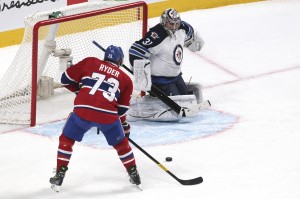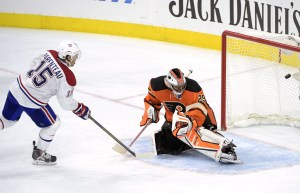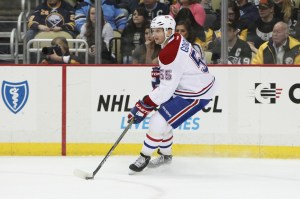Montreal Canadiens general manager Marc Bergevin has built a reputation for himself as one of the best executives in the National Hockey League in his two and a half seasons at the helm of the Habs. Bergevin started his new role on May 2nd , 2012 after the Canadiens had one of their worst seasons in franchise history, finishing with 78 points. In the last 60 years, the Habs only finished with less points five times. The Canadiens finished last in the Eastern Conference that season, and 28th overall in the 30 team league.
The Canadiens fired head coach Jacques Martin midseason, overhauled the front office by sending GM Pierre Gauthier packing, traded top goal scorer Michael Cammalleri not just midseason, but mid-game, and gave no guarantees to interim head coach Randy Cunneyworth.
Since then, the franchise in turmoil has won an Atlantic Division title, made a run to the Eastern Conference Final, and is currently among the few teams battling for first overall in the East standings. Much of the credit for the rapid turnaround has been heaped on Marc Bergevin. It makes sense that the man who has the final say on all trades, signings and draft picks would deserve praise, but let’s take a closer look to see just how much credit Bergevin has earned for the Canadiens going from the Eastern Conference cellar, to one of the beasts of the East so quickly.
We have already taken a closer look at Bergevin’s history of signings, and draft picks earlier this week. Now we will analyze the trades made by the current Habs general manager.
Bergevin’s first deal was a very minor one, sending Brendon Nash to the Florida Panthers for Jason DeSantis. The two will combine to play two career NHL games, with Nash suiting up for a pair of contests with the Habs in 2011. The next trade in Bergevin’s tenure appeared to be a minor one at the time, sending Cedrick Desjardins to the Tampa Bay Lightning in exchange for Dustin Tokarski. However, Tokarski has since blossomed into the Habs number two netminder, and played admirably in the Eastern Conference Final when Carey Price was injured in Game One.
Desjardins on the other hand, has made a handful of appearances for the Lightning, but is currently playing in the AHL for the Hartford Wolf Pack, the top affiliate of the New York Rangers. Though both Tokarski and Desjardins turned pro with the pedigree of being Memorial Cup winners, it appears Tokarski is the better option today.
Bergevin Keeps Eye On Future Cap Space
With the Habs chasing down the Atlantic Division title in the 2013 season, Bergevin bolstered their lineup by bringing back Michael Ryder from the Dallas Stars, along with a third round draft pick, while shipping struggling winger Erik Cole to the Lone Star State. Cole had scored just three goals and six points in 19 games with the Canadiens prior to the deal, and Ryder fit in well immediately upon returning to Montreal, scoring 21 points in 27 games.

Also, with the Canadiens also near the salary cap, they entered the 2013 offseason with much more flexibility, as Ryder was an unrestricted free agent, and the Stars are still paying Cole $4.5 million until the end of this season. Considering Cole has just 60 points in 148 games with the Stars, the cap savings alone was a win for the Habs. Adding in 21 points in 27 games from Ryder and a third round pick that was used to select Connor Crisp was just icing on the already won trade.
Bergevin also acquired blue line depth at the 2013 trade deadline by adding David Drewiske from the Los Angeles Kings for a 5th round pick. The following offseason, about bowing out of the playoffs in the first round, Bergevin wanted to add some muscle to the lineup. He sent a 7th round pick and a low level prospect in Phillippe Lefebvre to the Florida Panthers for George Parros, likely the most intimidating fighter in the league at the time. He also sent Danny Kristo to the New York Rangers for Christian Thomas. Both players have played well in the AHL thus far, but neither have left a mark in the NHL yet. Thomas is two years younger at 22, and has made his debut with the Habs recently, displaying great speed and a blistering shot, but it is too early yet to say who won this deal.
Canucks Would Like Do-Over On Weise Trade
With the Habs performing well in the standings again in the 2013-14 season, Bergevin made a mid-season deal to acquire Dale Weise for seldom used defenseman Raphael Diaz. It was uncertain if Weise would even be a regular in the Habs lineup when the trade was made, but he was invaluable in the postseason, scoring seven points from the fourth line, including some of the biggest goals of the Habs run to the Eastern Conference Final. Weise’s 18 points in 47 games this season prove he is more valuable than Diaz, who landed in Calgary and is in and out of the Flames lineup. Weise’s surprising offense have even landed him on the Habs top line with Max Pacioretty at times, though no one expects him to stay there long term.
When the 2014 deadline arrived, the Habs were well behind the Boston Bruins for first in the Atlantic Division, but still among the top teams in the East. Bergevin made two key moves, bringing in veteran defenseman Mike Weaver for a 5th round pick, and also dealing a 2nd round pick and Sebastien Collberg to the New York Islanders for Thomas Vanek, perhaps the most coveted player who was available at the time.
https://www.youtube.com/watch?v=5J2eI8HYfmA
Vanek disappeared at times in the postseason, but his 15 points in 18 regular season games, and ten points in 17 playoff games were a huge help for the Habs down the stretch of the season and into the postseason. If Collberg turns into a top six scorer, and Johnathan MacLeod, the defenseman chosen with the 2nd round pick in the deal, turns into a solid NHL defender, this trade will look awful in hindsight. However, it definitely appeared at the time that the Vanek trade was a risk worth taking.

With the 2014 trip to the Eastern Conference Final in the rearview mirror, Bergevin sent Daniel Briere to the Colorado Avalanche in exchange for P.A. Parenteau and a 5th round pick. Briere struggled in his one season with the Habs, and Parenteau being a natural right winger, was a much better fit on the current Habs roster. He hasn’t exactly been on fire since arriving in Montreal, scoring 15 points in 40 games this season, but compared to Briere’s 11 points in 43 games with the Avs it appears the trade was fairly even. Parenteau has an extra year on his current deal, but the Habs added a late draft pick in the trade. When you consider Parenteau’s exceptional performance in the shootout this season, Parenteau is 4 for 6 with 4 game deciding goals, we can give the slight edge in the deal to the Habs.
The next day, before the free agent frenzy began on July 1st, Bergevin dealt defenseman Josh Gorges to the Buffalo Sabres for a 2nd round pick in the 2016 draft. Gorges has struggled this season, but much of that can be attributed to the fact he is playing for the lowly Sabres, who recently ended a 14 game losing streak with a win over the Canadiens.
https://twitter.com/SteveBurtch/status/557395893822181376
The problem with keeping Gorges was his $3.9 million cap hit that has three more years on it after this season. As one of the top shot blockers in the league, Gorges’ play is starting to fade, and at 30 years of age it was the best choice for Bergevin to move him while he could still get a valuable draft pick in return.
Habs Have Tons Of Cap Space This Summer
Bergevin’s last two deals put the Habs against the salary cap ceiling this season, but will give them plenty of wiggle room next season. First, he moved depth winger Travis Moen to the Dallas Stars for Sergei Gonchar. Moen has another year on his contract at $1.85 million, while Gonchar will be a UFA this summer.
Moen is still a valuable penalty killer, but was passed on the depth chart by Michael Bournival and Dale Weise and didn’t have much of a role with the Habs anymore. Gonchar has fit in well since arriving in the deal, and is mentoring Nathan Beaulieu on what has become a solid second defense pairing for the Canadiens.

Similarly, Bergevin found a taker for Rene Bourque’s hefty contract, and got a pending UFA in return when he acquired Bryan Allen from the Anaheim Ducks. Bourque’s $3.33 million dollar cap hit will be on the Ducks cap this season and next, while Allen will walk away as a UFA from the Montreal Canadiens this summer after being acquired on November 20th.
Allen played five games with the Habs before being sent down to the Hamilton Bulldogs, but Bourque’s struggles continue in Anaheim where he has two goals and seven points in 24 contests. Just clearing cap space off the books for next season makes this trade a huge win for the Habs.
These two recent trades, along with the Gorges deal in July, save the Montreal Canadiens more than nine million dollars entering next summer. Whether Bergevin uses the cap space to sign a player this upcoming July, or makes a trade to acquire a quality player from a capped-out team, much like the New York Islanders did this past summer when they added Johnny Boychuk from the Boston Bruins and Nick Leddy from the Chicago Blackhawks, the Canadiens are in a position to greatly improve their team this summer thanks a trio of trades made by Bergevin, who always has one eye on the future.
#Habs Bergevin: Recent shedding of Moen and Bourque contracts created cap space and opportunity to swing the Gallagher deal.
— John Lu (@JohnLuTSNWpg) November 29, 2014
Overall, Bergevin’s biggest trade may have been the Vanek acquisition, but he has rarely swung for the fences in deals. Many of his trades were for minor upgrades (Weaver, Parenteau) or to save cap space for the future (Bourque, Moen, Gorges). Though he hasn’t acquired any franchise players via trade, an argument could be made that Bergevin is yet to come out on the losing end of any deal since he took over as Habs GM.
Combine his small victories on the trade market, with his slow methodical draft philosophy, and it becomes clear that Bergevin has done an exceptional job as the GM of the Canadiens thus far. The team is already set up to be a great team in the near future, and have a chance to fast forward that process with the cap space that will be available to them this summer.